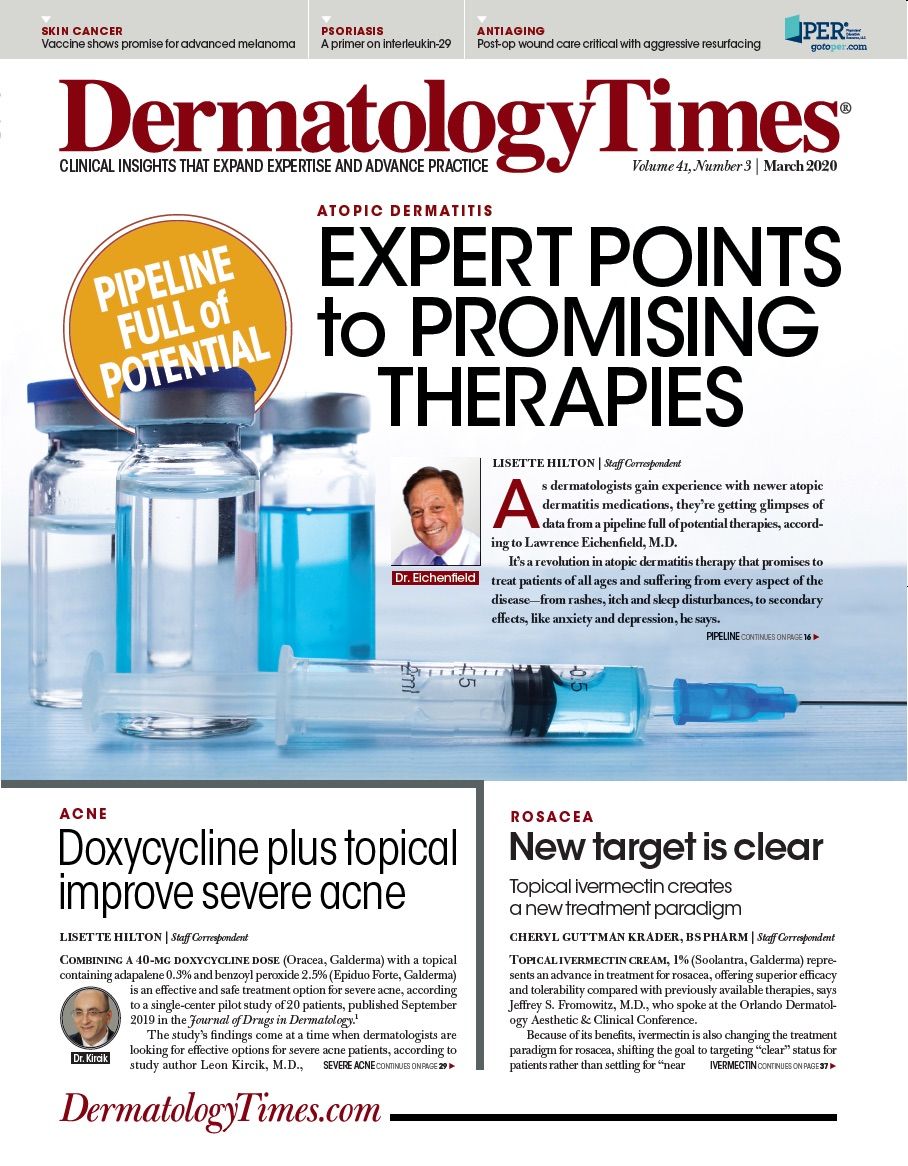- Case-Based Roundtable
- General Dermatology
- Eczema
- Chronic Hand Eczema
- Alopecia
- Aesthetics
- Vitiligo
- COVID-19
- Actinic Keratosis
- Precision Medicine and Biologics
- Rare Disease
- Wound Care
- Rosacea
- Psoriasis
- Psoriatic Arthritis
- Atopic Dermatitis
- Melasma
- NP and PA
- Skin Cancer
- Hidradenitis Suppurativa
- Drug Watch
- Pigmentary Disorders
- Acne
- Pediatric Dermatology
- Practice Management
- Prurigo Nodularis
- Buy-and-Bill
Publication
Article
Dermatology Times
Rhinophyma treatment, prevention strategies
Author(s):
Rhinophyma is a disfiguring condition with deleterious psychosocial and functional consequences, and its pathogenesis remains unclear. Deborah S. Sarno ff, M.D., offers insight on its etiology, and treatment options in this article.

Rhinophyma is a cosmetically deformative condition with unmet needs - both in understanding etiology and in treatment options, says Deborah S. Sarnoff, M.D., clinical professor of dermatology, NYU Langone School of Medicine, New York, and director of dermatologic surgery, Cosmetique Dermatology, Laser & Plastic Surgery, New York.
RELATED: Topical rosacea cream creates new treatment paradigm
“Rhinophyma is a very embarrassing and humiliating problem with enormous negative psychosocial implications resulting from its disfigurement and alleged association with alcohol use, and it can also have functional consequences, interfering with breathing, sleeping, eating, drinking and, even, vision,” Dr. Sarnoff says. “In recent years there have been some medical advances for masking and controlling the redness associated with rhinophyma, but surgery is still the only option for correcting the deformity. The field is wide open for researchers who are interested in developing new modalities for rhinophyma prevention and treatment,” she says.
EPIDEMIOLOGY AND ETIOLOGY
Rhinophyma is a subtype of rosacea characterized by thickened skin and enlargement of sebaceous glands, and there can also be prominent telangiectasias, venulectasias and pores. The pathology involves the skin, not cartilage or bone, and it most often affects the nose - usually the lower two-thirds. However, phymatous changes can also develop on the forehead, ears, chin and eyelids.
Although rosacea is much more common in women, men with rosacea are at greater risk to develop rhinophyma than their female counterparts. In addition, rhinophyma is seen more often in Caucasians than in other racial groups, and particularly in Caucasians with very fair skin.
“A reason for these differences is not known. They suggest there may be a hormonal or genetic component contributing to rhinophyma, and other theories propose Demodex mites, ultraviolet light exposure, heat, vitamin defficiency and alcohol or caffeine use may be causative or exacerbating factors,” Dr. Sarno says.
“Likely, the etiology is multifactorial,” she adds.
RELATED: Sol-Gel’s rosacea cream may offer patients rapid relief
The phymatous changes are thought to result from unregulated superficial vasodilation and vascular instability, leading to lymph extravasation into surrounding tissues. Chronic edema from accumulating lymph incites an in ammatory reaction that results in fibrosis and sebaceous hyperplasia.
“In people who wear eyeglasses, pressure from the nose pads may particularly restrict lymph drainage and explain the localization of phymatous changes to the lower two-thirds of the nose,” Dr. Sarnoff observes.
TREATMENT OPTIONS
Vascular-specific lasers or intense pulsed light treatment targeting blood vessels can be used to reduce redness and telangiectasias. Medical treatments that can help relieve redness include topical ivermectin, brimonidine and oxymetazoline as well as oral aspirin, clonidine and propranolol.
Surgery using physically destructive techniques, however, remains the only option for tissue contouring. Preferred approaches include the bloodless heated scalpel technique, radiofrequency ablation, electrosurgery and laser resurfacing using a carbon dioxide, erbium:YAG, or neodynium:YAG laser.
Offering pearls for nasal sculpting, Dr. Sarnoff advises asking patients to bring in a personal photograph taken at a younger age before the onset of rhinophyma to serve as a guide. She also cautioned being conservative with tissue removal and removing slightly less tissue than considered necessary to allow for post-procedure fibrosis and contraction.
RELATED: Combination therapy significantly improves rosacea symptoms
“Less is more. You can always go back if additional sculpting is desired, but taking off too much tissue and going below the depth of the pilosebaceous apparatus will result in a waxy, shiny, hypopigmented appearance,” Dr. Sarnoff says.
Therefore, she suggests dividing the sculpting into two sessions. Debulking is the goal for the first procedure while the second is designed to fine-tune the result.
Because cancers can be masked by sebaceous hyperplasia, tissue removed in sculpting should be sent for pathologic review, especially if it is taken from an area of ulcerated skin.
“If there is any doubt over whether there might be a basal cell or squamous cell carcinoma, put some tissue in a bottle and send it to the pathologist,” Dr. Sarnoff says.
PREVENTIVE STRATEGIES
There is evidence that chronic low-dose isotretinoin (5-10 mg/day) started at an early stage of rhinophyma can help reduce sebaceous overgrowth. In addition, there has been interest in the use of tamoxifen that can downregulate transforming growth factor-β2 (TGF-β2), a fibrogenic cytokine overexpressed in rhinophyma, or in various anti-neoplastic drugs that suppress fibroblast proliferation.
RELATED: How to diagnose rosacea in skin of color patients
“Studies are needed to investigate whether these drugs might be helpful for limiting the progression of phymatous rosacea, including the route of administration that could offer the best risk:benefit profile,” Dr. Sarnoff says







